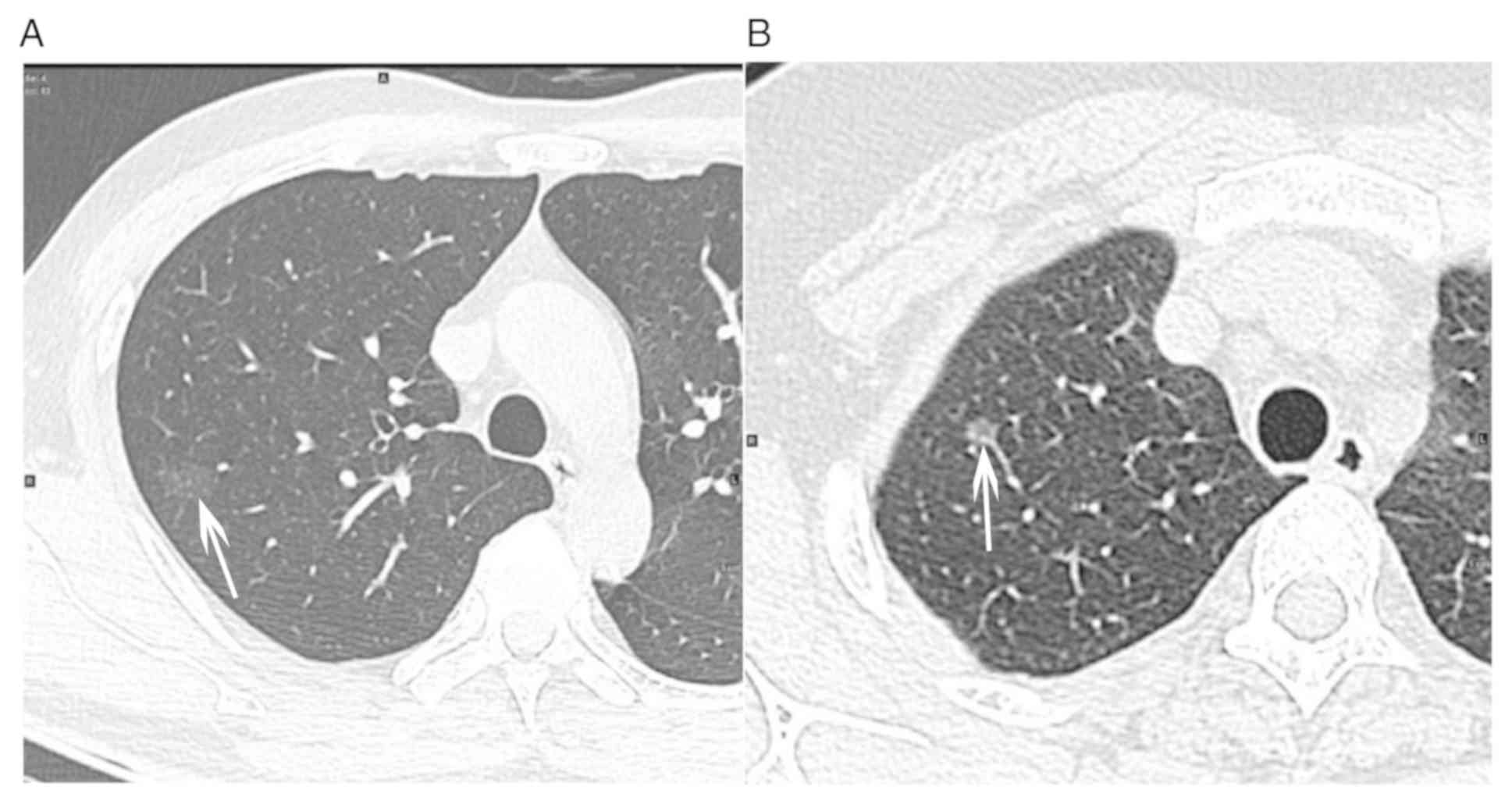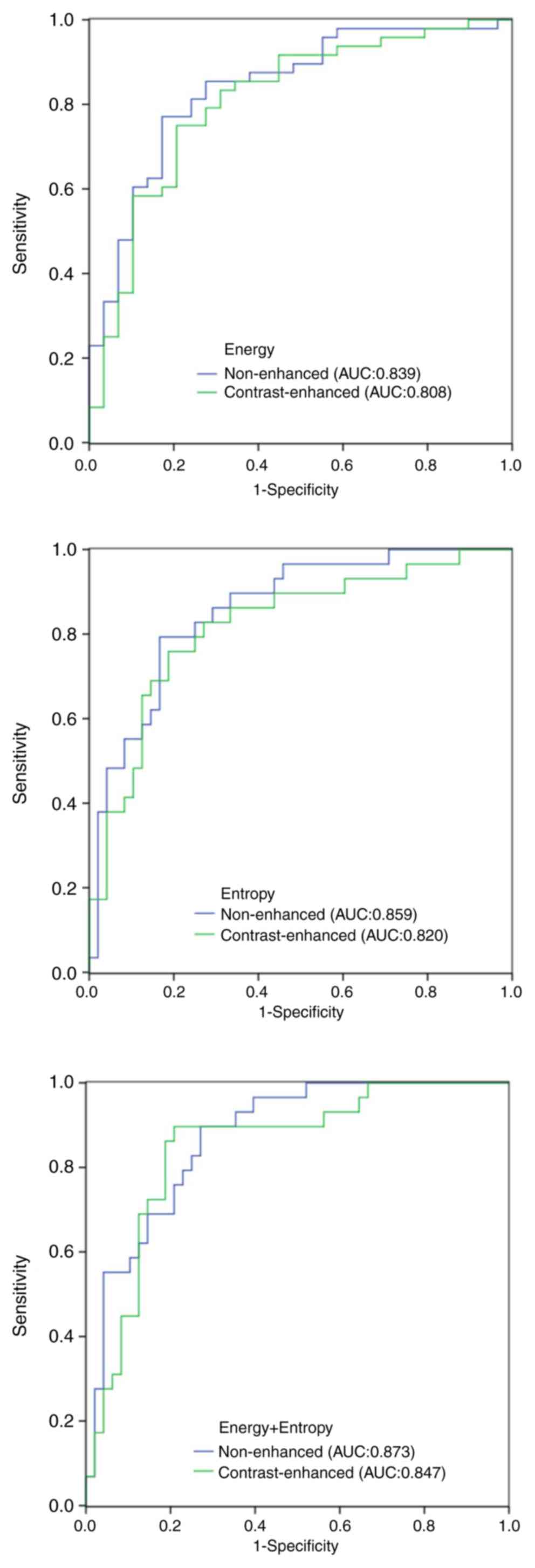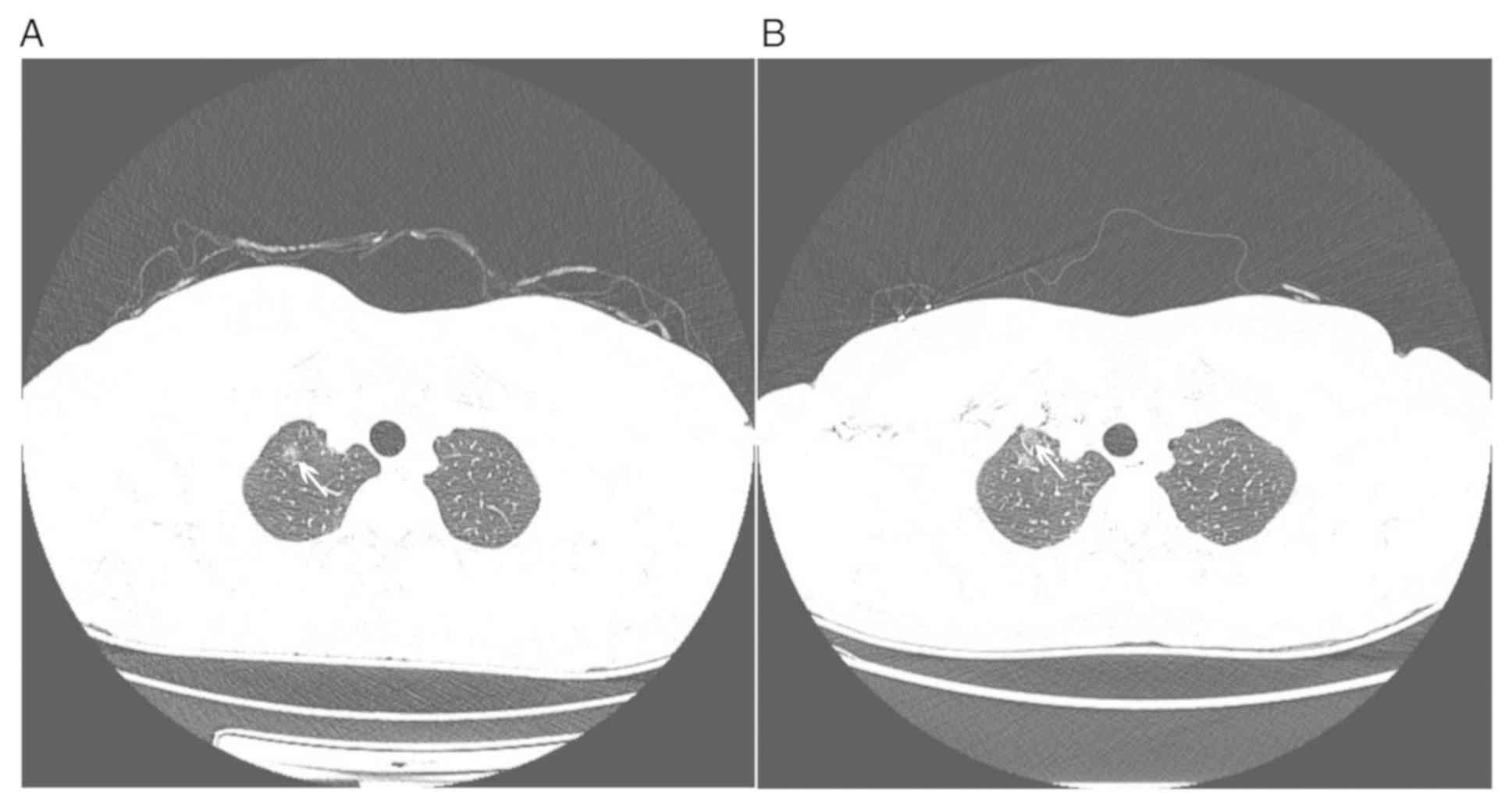|
1
|
Travis WD, Brambilla E, Noguchi M,
Nicholson AG, Geisinger KR, Yatabe Y, Beer DG, Powell CA, Riely GJ,
Van Schil PE, et al: International association for the study of
lung cancer/american thoracic society/european respiratory society
international multidisciplinary classification of lung
adenocarcinoma. J Thorac Oncol. 6:244–285. 2011.PubMed/NCBI View Article : Google Scholar
|
|
2
|
Borczuk AC, Qian F, Kazeros A, Eleazar J,
Assaad A, Sonett JR, Ginsburg M, Gorenstein L and Powell CA:
Invasive size is an independent predictor of survival in pulmonary
adenocarcinoma. Am J Surg Pathol. 33:462–469. 2009.PubMed/NCBI View Article : Google Scholar
|
|
3
|
Zhang J, Wu J, Tan Q, Zhu L and Gao W: Why
do pathological stage IA lung adenocarcinomas vary from prognosis?:
A clinicopathologic study of 176 patients with pathological stage
IA lung adenocarcinoma based on the IASLC/ATS/ERS classification. J
Thorac Oncol. 8:1196–1202. 2013.PubMed/NCBI View Article : Google Scholar
|
|
4
|
Kim HY, Shim YM, Lee KS, Han J, Yi CA and
Kim YK: Persistent pulmonary nodular ground-glass opacity at
thin-section CT: Histopathologic comparisons. Radiology.
245:267–275. 2007.PubMed/NCBI View Article : Google Scholar
|
|
5
|
Lee SM, Park CM, Goo JM, Lee HJ, Wi JY and
Kang CH: Invasive pulmonary adenocarcinomas versus preinvasive
lesions appearing as ground-glass nodules: Differentiation by using
CT features. Radiology. 268:265–273. 2013.PubMed/NCBI View Article : Google Scholar
|
|
6
|
Lee HJ, Goo JM, Lee CH, Yoo CG, Kim YT and
Im JG: Nodular ground-glass opacities on thin-section CT: Size
change during follow-up and pathological results. Korean J Radiol.
8:22–31. 2007.PubMed/NCBI View Article : Google Scholar
|
|
7
|
Park CM, Goo JM, Lee HJ, Lee CH, Chun EJ
and Im JG: Nodular ground-glass opacity at thin-section CT:
Histologic correlation and evaluation of change at follow-up.
Radiographics. 27:391–408. 2007.PubMed/NCBI View Article : Google Scholar
|
|
8
|
Lee HY and Lee KS: Ground-glass opacity
nodules: Histopathology, imaging evaluation, and clinical
implications. J Thorac Imaging. 26:106–118. 2011.PubMed/NCBI View Article : Google Scholar
|
|
9
|
Travis WD, Garg K, Franklin WA, Wistuba
II, Sabloff B, Noguchi M, Kakinuma R, Zakowski M, Ginsberg M,
Padera R, et al: Evolving concepts in the pathology and computed
tomography imaging of lung adenocarcinoma and bronchioloalveolar
carcinoma. J Clin Oncol. 23:3279–3287. 2005.PubMed/NCBI View Article : Google Scholar
|
|
10
|
Lim HJ, Ahn S, Lee KS, Han J, Shim YM, Woo
S, Kim JH, Yie M, Lee HY and Yi CA: Persistent pure ground-glass
opacity lung nodules ≥ 10 mm in diameter at CT scan:
Histopathologic comparisons and prognostic implications. Chest.
144:1291–1299. 2013.PubMed/NCBI View Article : Google Scholar
|
|
11
|
Nelson DA, Tan TT, Rabson AB, Anderson D,
Degenhardt K and White E: Hypoxia and defective apoptosis drive
genomic instability and tumorigenesis. Genes Dev. 18:2095–2107.
2004.PubMed/NCBI View Article : Google Scholar
|
|
12
|
Ganeshan B and Miles KA: Quantifying
tumour heterogeneity with CT. Cancer Imaging. 13:140–149.
2013.PubMed/NCBI View Article : Google Scholar
|
|
13
|
Lee SW, Leem CS, Kim TJ, Lee KW, Chung JH,
Jheon S, Lee JH and Lee CT: The long-term course of ground-glass
opacities detected on thin-section computed tomography. Respir Med.
107:904–910. 2013.PubMed/NCBI View Article : Google Scholar
|
|
14
|
Lee HJ, Goo JM, Lee CH, Park CM, Kim KG,
Park EA and Lee HY: Predictive CT findings of malignancy in
ground-glass nodules on thin-section chest CT: The effects on
radiologist performance. Eur Radiol. 19:552–560. 2009.PubMed/NCBI View Article : Google Scholar
|
|
15
|
Aoki T, Tomoda Y, Watanabe H, Nakata H,
Kasai T, Hashimoto H, Kodate M, Osaki T and Yasumoto K: Peripheral
lung adenocarcinoma: Correlation of thin-section CT findings with
histologic prognostic factors and survival. Radiology. 220:803–809.
2001.PubMed/NCBI View Article : Google Scholar
|
|
16
|
Lee SH, Lee SM, Goo JM, Kim KG, Kim YJ and
Park CM: Usefulness of texture analysis in differentiating
transient from persistent part-solid nodules(PSNs): A retrospective
study. PLoS One. 9(e85167)2014.PubMed/NCBI View Article : Google Scholar
|
|
17
|
Son JY, Lee HY, Lee KS, Kim JH, Han J,
Jeong JY, Kwon OJ and Shim YM: Quantitative CT analysis of
pulmonary ground-glass opacity nodules for the distinction of
invasive adenocarcinoma from pre-invasive or minimally invasive
adenocarcinoma. PLoS One. 9(e104066)2014.PubMed/NCBI View Article : Google Scholar
|
|
18
|
Chae HD, Park CM, Park SJ, Lee SM, Kim KG
and Goo JM: Computerized texture analysis of persistent part-solid
ground-glass nodules: Differentiation of preinvasive lesions from
invasive pulmonary adenocarcinomas. Radiology. 273:285–293.
2014.PubMed/NCBI View Article : Google Scholar
|
|
19
|
Li W, Wang X, Zhang Y, Li X, Li Q and Ye
Z: Radiomic analysis of pulmonary ground-glass opacity nodules for
distinction of preinvasive lesions, invasive pulmonary
adenocarcinoma and minimally invasive adenocarcinoma based on
quantitative texture analysis of CT. Chin J Cancer Res. 30:415–424.
2018.PubMed/NCBI View Article : Google Scholar
|
|
20
|
Liu Y, Liu S, Qu F, Li Q, Cheng R and Ye
Z: Tumor heterogeneity assessed by texture analysis on
contrast-enhanced CT in lung adenocarcinoma: Association with
pathologic grade. Oncotarget. 8:53664–53674. 2017.PubMed/NCBI View Article : Google Scholar
|
|
21
|
Suo S, Cheng J, Cao M, Lu Q, Yin Y, Xu J
and Wu H: Assessment of heterogeneity difference between edge and
core by using texture analysis: Differentiation of malignant from
inflammatory pulmonary nodules and masses. Acad Radiol.
23:1115–1122. 2016.PubMed/NCBI View Article : Google Scholar
|
|
22
|
Fujimoto K, Tonan T, Azuma S, Kage M,
Nakashima O, Johkoh T, Hayabuchi N, Okuda K, Kawaguchi T, Sata M
and Qayyum A: Evaluation of the mean and entropy of apparent
diffusion coefficient values in chronic hepatitis C: Correlation
with pathologic fibrosis stage and inflammatory activity grade.
Radiology. 258:739–748. 2011.PubMed/NCBI View Article : Google Scholar
|
|
23
|
Kierans AS, Bennett GL, Mussi TC, Babb JS,
Rusinek H, Melamed J and Rosenkrantz AB: Characterization of
malignancy of adnexal lesions using ADC entropy: Comparison with
mean ADC and qualitative DWI assessment. J Magn Reson Imaging.
37:164–171. 2013.PubMed/NCBI View Article : Google Scholar
|
|
24
|
Cao MQ, Suo ST, Zhang XB, Zhong YC, Zhuang
ZG, Cheng JJ, Chi JC and Xu JR: Entropy of T2-weighted imaging
combined with apparent diffusion coefficient in prediction of
uterine leiomyoma volume response after uterine artery
embolization. Acad Radiol. 21:437–444. 2014.PubMed/NCBI View Article : Google Scholar
|
|
25
|
Ganeshan B, Miles KA, Young RC and Chatwin
CR: Hepatic entropy and uniformity: Additional parameters that can
potentially increase the effectiveness of contrast enhancement
during abdominal CT. Clin Radiol. 62:761–768. 2007.PubMed/NCBI View Article : Google Scholar
|
|
26
|
Chandarana H, Rosenkrantz AB, Mussi TC,
Kim S, Ahmad AA, Raj SD, McMenamy J, Melamed J, Babb JS, Kiefer B
and Kiraly AP: Histogram analysis of whole-lesion enhancement in
differentiating clear cell from papillary subtype of renal cell
cancer. Radiology. 265:790–798. 2012.PubMed/NCBI View Article : Google Scholar
|
|
27
|
Wang S, Kim S, Zhang Y, Wang L, Lee EB,
Syre P, Poptani H, Melhem ER and Lee JY: Determination of grade and
subtype of meningiomas by using histogram analysis of
diffusion-tensor imaging metrics. Radiology. 262:584–592.
2012.PubMed/NCBI View Article : Google Scholar
|
|
28
|
Ganeshan B, Abaleke S, Young RC, Chatwin
CR and Miles KA: Texture analysis of non-small cell lung cancer on
unenhanced computed tomography: Initial evidence for a relationship
with tumour glucose metabolism and stage. Cancer Imaging.
10:137–143. 2010.PubMed/NCBI View Article : Google Scholar
|
|
29
|
Ravanelli M, Farina D, Morassi M, Roca E,
Cavalleri G, Tassi G and Maroldi R: Texture analysis of advanced
non-small cell lung cancer (NSCLC) on contrast-enhanced computed
tomography: Prediction of the response to the first-line
chemotherapy. Eur Radiol. 23:3450–3455. 2013.PubMed/NCBI View Article : Google Scholar
|












